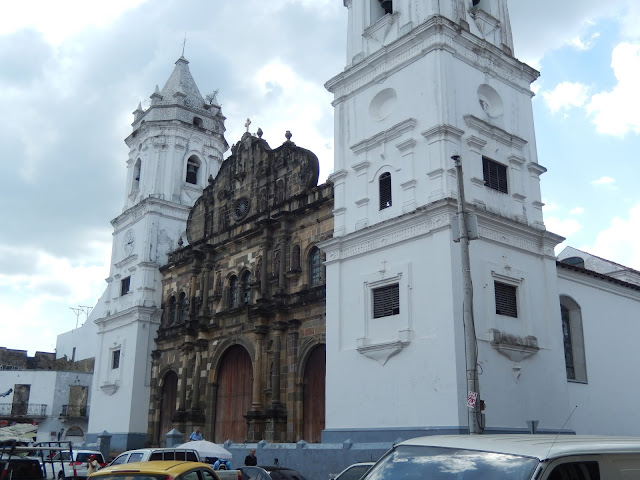David, our guide, met us at the dock. He was a high school teacher but is now a licensed tour guide. He has a master's degree and has to take a lot of credits every year to keep us his tour guide license. He is young, cute, and has Mayan features. David says we will see the way people really live, and I believe we did.
Our first stop is the town of Tuxtla Chico. It is a small town with no hotels and no trendy restaurants. First we see the church, Santa Maria del Candelaria.. It is 400 years old. It is simple and elegant and airy. The walls are whitewashed. The roof and doors are made of local wood. There are lots of wood statutes of the Virgin inside.
Right around the corner we find the local market. It is an open air market about two or three blocks long. There are lots of unidentifiable fruits and vegetables and herbs. There are raw chicken presided over by women with fly-swatters. There was something about the size of a rabbit that had been roasted. David said it was a "local animal." This market did not cater to tourists.
Next, we were taken to the town square where there were some statutes and a big pavillion. There were a few booths here selling touristy stuff: local chocolate, toys, embroidered items, jewelry. In the pavilion a group plays the "municipal marimbas." Apparently, each town owns some marimbas. They played familiar songs such as The Mexican Hat Dance. Some local women in Spanish-looking dresses danced on the stage. Their dancing was pretty lame. Mostly they just shifted from foot to foot. Then some other women came and did a "local dance" with bandanas that was somewhat better. Then members of the tour group were recruited to join in the dancing and it ended with a conga line.
Finally, our group went to a table at the back of the stage to see a chocolate demonstration. Chocolate comes from the cacao plant. It grows in a big yellow pod about the size of a large papaya. The outside is very hard. If you crack two of them together they will break in half. Inside there are white seeds (which are bitter at this stage) and some white slimy goop. They take the seeds out and dry them for three days. The goop is used to make some kind of healthy kind of water drink which we got to taste. The seeds are roasted and they turn dark brown or black. We tasted some. They are smoky and a little bitter, but in a good way. Next, the beans are pulverized and mixed with sugar and cinnamon on a stone called a metate. It becomes a granular, moldable mass. It tastes smoky and has a grainy texture. I didn't like it that nuch. The locals don't eat chocolate as candy. They mix it with milk or water and drink it as a hot drink.
We returned to the bus and after a short ride we arrived at Izapa, a Mayan city built around 1500 BCE. Izapa is, perhaps, the oldest known Mayan city. We saw some smallish pyramids and a place where a Mayan ball game was played.
Photos to be added when I return home.


















